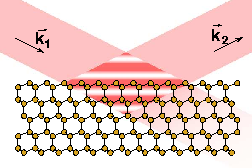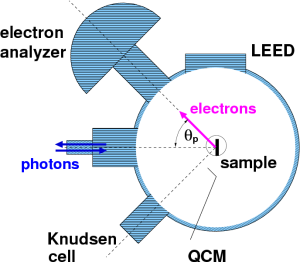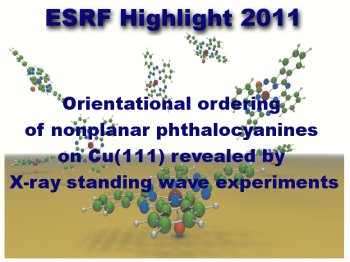X-ray Standing Waves
The X-ray standing wave (XSW) technique is a method particularly suitable for studying organic thin films in the
monolayer regime. It provides element specific structural information of adsorbed molecules and their complex
interaction with the substrate.
|
 The standing wave field is produced by Bragg
reflection of monochromatic X-rays from a single crystal substrate. When scanning through a Bragg condition
the phase of the X-ray interference field changes by π and, consequently, the nodal planes shift by half a
lattice constant. (Move mouse pointer over the picture on the left.) The standing wave field is produced by Bragg
reflection of monochromatic X-rays from a single crystal substrate. When scanning through a Bragg condition
the phase of the X-ray interference field changes by π and, consequently, the nodal planes shift by half a
lattice constant. (Move mouse pointer over the picture on the left.)
Due to photoexcitation processes within the adlayer electrons and fluorescence light are emitted. The
variation of the photoelectron (fluorescence) yield when scanning through the Bragg condition - by changing
the photon energy or incidence angle - depends on the adsorbate position, see
this simulation.
|
Therefore element specfic atomic positions of adsorbates on crystalline substrates can be extracted. Further
details can be found in this more quantitative introduction
to the XSW technique.
As adsorbate studies require clean surfaces, the substrates are held under ultra-high vacuum conditions.
- The monolayer films are prepared in situ by organic molecular beam
deposition.
- Synchrotron light with tunable energy is used to match the Bragg condition
in backreflection geometry.
- The photoelectrons created by the XSW field are
measured with a hemispherical electron analyzer. For each element a series of spectra is obtained which can
be used to extract the relative photoelectron yield.
|

|
|
 In a project carried out at beamline
ID32 of the ESRF we studied the adsorption geometry and orientational ordering of chlorogallium phthalocyanine
molecules (GaClPc) on Cu(111) by using the x-ray standing wave technique, photoelectron spectroscopy, and
quantum mechanical calculations. We find that for submonolayer coverages on Cu(111) the majority of GaClPc
molecules adsorb in a Cl-down configuration by forming a covalent bond to the substrate. For bilayer coverages
the x-ray standing wave data indicate a coexistence of the Cl-down and Cl-up configurations on the
substrate. The structural details established for both cases and supplementary calculations of the adsorbate
system allow us to analyze the observed change of the work function. In a project carried out at beamline
ID32 of the ESRF we studied the adsorption geometry and orientational ordering of chlorogallium phthalocyanine
molecules (GaClPc) on Cu(111) by using the x-ray standing wave technique, photoelectron spectroscopy, and
quantum mechanical calculations. We find that for submonolayer coverages on Cu(111) the majority of GaClPc
molecules adsorb in a Cl-down configuration by forming a covalent bond to the substrate. For bilayer coverages
the x-ray standing wave data indicate a coexistence of the Cl-down and Cl-up configurations on the
substrate. The structural details established for both cases and supplementary calculations of the adsorbate
system allow us to analyze the observed change of the work function.
|
For our work using the XSW technique see also this ESRF Spotlight on Science,
the ESRF
Highlights 2008, the ESRF Highlights 2011, and our list of publications.
Recomended review articles on the XSW technique:
[1] J. Zegenhagen. Surf. Sci. Rep. 18(7/8) (1993) 199
[2] D. P. Woodruff, Rep. Prog. Phys. 68(4) (2005) 743
[3] M. J. Bedzyk and L. Cheng, Rev. Mineral. Geochem. 49 (2002) 221
[4] A. Franco-Cañellas, S. Duhm, A. Gerlach, and F. Schreiber, Rep. Prog. Phys. 83 (2020) 066501
 The standing wave field is produced by Bragg
reflection of monochromatic X-rays from a single crystal substrate. When scanning through a Bragg condition
the phase of the X-ray interference field changes by π and, consequently, the nodal planes shift by half a
lattice constant. (Move mouse pointer over the picture on the left.)
The standing wave field is produced by Bragg
reflection of monochromatic X-rays from a single crystal substrate. When scanning through a Bragg condition
the phase of the X-ray interference field changes by π and, consequently, the nodal planes shift by half a
lattice constant. (Move mouse pointer over the picture on the left.)
 In a project carried out at beamline
ID32 of the ESRF we studied the adsorption geometry and orientational ordering of chlorogallium phthalocyanine
molecules (GaClPc) on Cu(111) by using the x-ray standing wave technique, photoelectron spectroscopy, and
quantum mechanical calculations. We find that for submonolayer coverages on Cu(111) the majority of GaClPc
molecules adsorb in a Cl-down configuration by forming a covalent bond to the substrate. For bilayer coverages
the x-ray standing wave data indicate a coexistence of the Cl-down and Cl-up configurations on the
substrate. The structural details established for both cases and supplementary calculations of the adsorbate
system allow us to analyze the observed change of the work function.
In a project carried out at beamline
ID32 of the ESRF we studied the adsorption geometry and orientational ordering of chlorogallium phthalocyanine
molecules (GaClPc) on Cu(111) by using the x-ray standing wave technique, photoelectron spectroscopy, and
quantum mechanical calculations. We find that for submonolayer coverages on Cu(111) the majority of GaClPc
molecules adsorb in a Cl-down configuration by forming a covalent bond to the substrate. For bilayer coverages
the x-ray standing wave data indicate a coexistence of the Cl-down and Cl-up configurations on the
substrate. The structural details established for both cases and supplementary calculations of the adsorbate
system allow us to analyze the observed change of the work function.